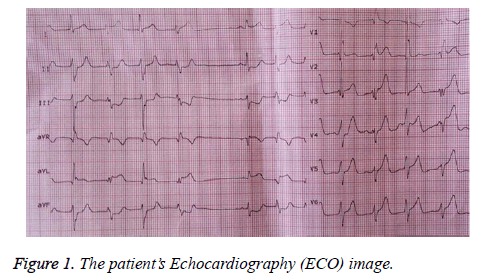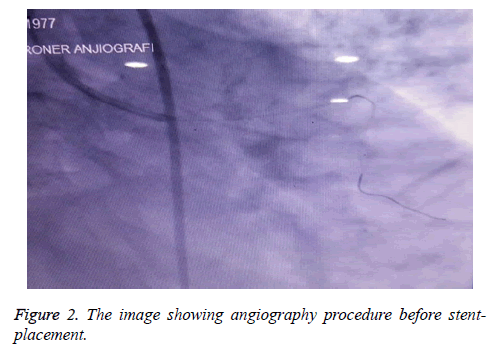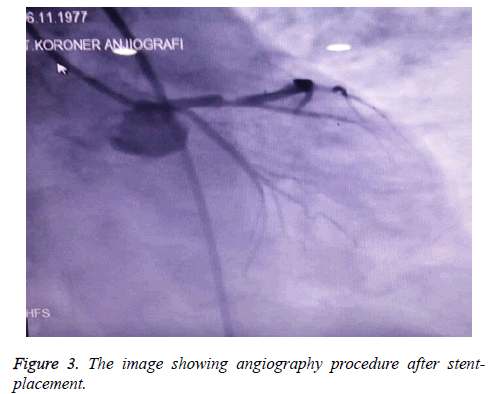Case Report - Biomedical Research (2017) Volume 28, Issue 11
Cardiovascular risk of levetiracetam overdose for bonsai addiction: arrhythmia and myocardial infarction
Abdullah Algin1*, Irfan Aydin1, Mehmet Kaan Poyraz1 and Mehmet Hakan Taşolar2
1Department of Emergency Medicine, Adiyaman University, Research and Educational Hospital, Adiyaman, Turkey
2Department of Cardiology, Adiyaman University, Research and Educational Hospital, Adiyaman, Turkey
- *Corresponding Author:
- Abdullah Algin
Department of Emergency Medicine
Adiyaman University
Research and Educational Hospital
Turkey
Accepted date: April 24, 2017
Abstract
Introduction: Levetiracetam is indicated as monotherapy in the treatment of partial onset seizures. Levetiracetam overdose has many neurological and psychiatric issues, but rarely cardiovascular toxicity. We report a large ingestion of levetiracetam drug in the patient with Bonsai addiction that resulted in arrhythmia and Myocard Infarct (MI).
Case Report: A 39 year old addicted male patient was brought up to emergency and presented oral ingestion of 16 g levetiracetam with arrhythmia, bradycardia and hypotension. Depression of D2, D3, and AVF ST Segments was present at second electrocardiogram, and revealed left ventricular hypokinesis. The patient urgently underwent angioplasty. The occlusion rate of the LAD coronary artery was at the level of 90%.
Discussion: Our report regrets this common acceptance of Levetiracetam overdose with one exception, in case of existence of addictive substance history. If the patient has an addictive substance history, which has potential to cause endothelial or atherosclerotic deterioration. Levetiracetam overdose may lead to fatal outcomes such as myocardial infarction by provoking occlusion.
Keywords
Levetiracetam overdose, Bonsai, Arrhythmia, Myocardial infarction
Introduction
Levetiracetam is suggested as mono-therapy in the care of short while ago diagnosed epilepsy by the whole of partial outset seizures or without secondarily generalized in new adults [1,2]. As well known, some suicide attempts have been papered for the patients used antiepileptic drugs like levetiracetam [3]. Many serious findings such as aggression, respiratory depression and coma were commonly encountered by levetiracetam overdose [4]. Since no specific antidote is currently available for levetiracetam, the unique treatment will be symptomatic in acute overdose care [5].
The best of our knowledge, there is one cardiovascular toxicity case of Levetiracetam presented with bradycardia and hypotension [6]. We here reported a case with acute ST-Segment Elevated Myocard Infarct (STEMI) due to large ingestion of levetiracetam.
Case Presentation
A 39-year-old addicted male patient was brought up to emergency by his relatives. The patient had orally received 16 g levetiracetam (16 tablets of 1000 mg; Epixx tablet, Abdi Ibrahim Pharmacy, Turkey) approximately 4 hours ago. He was a slight confit and nausea. Considering the ingested amounts and patient’s admission time, approximate levetiracetam concentration should be about 124 mg/ml 8 h post ingestion (absorption coefficient, 1.32 h-1, volume of distribution, and half-life elimination of 10 h; therapeutic range 10-40 mcg/ml). The case had a Glasgow Coma Scale of 14 with heart rate of 65/min (bpm) and blood pressure of 95/60 mmHg. His initial Electrocardiography (ECG) was arrhythmic with incomplete right bundle branch block and had no acute ischemic findings. In his history, there was no chronic disease. 1 g/kg of active coal was given through a nasogastric tube.
He complained chest pain with hypotension and bradycardia at the 1.5th h. Blood pressure was 70/40, and pulse was 53/min. ST segment elevation in the anterolateral leads and reciprocal ST segment depression in the inferior leads were observed on the following ECG (Figure 1). Cardiology consultation was done with STEMI pre-diagnosis. We applied sublingual and intravenous nitroglycerin to exclude vasospasm, but the patient’s chest pain and ST elevation were not resolved. Emergency coronary angiography was performed via the femoral artery and showed occlusion of the proximal left anterior descending artery at 90% rates (Figure 2). The occlusion did not change after intracoronary injection of isosorbide dinitrate. There were no other stenotic lesions in the other coronary arteries. Based on these findings, percutaneous coronary intervention of culprit lesion with sirolimus eluting stent was performed. After the treatment of occlusion without any complication, Angio presented great healing (Figure 3). The patient discharged from the hospital four days later.
Results
Discussion
Many serious findings such as aggression, respiratory depression and coma were commonly encountered by Levetiracetam overdose, but rarely cardio-vascular toxicity [2]. The best of our knowledge, there is only one cardio-vascular toxicity case of Levetiracetam presented with mild findings such as bradycardia and hypotension [6]. In this report, we report the first case of large Levetiracetam overdose presented with STEMI.
Page et al. has been reported the first cardiovascular toxicity of levetiracetam overdose with mild findings [6]. In this report, time course of the patient’s bradycardia and hypotension indicated that this was a toxic effect of levetiracetam overdose. Regular medications, co-ingested paracetamol/codeine combination product and ethanol were not expected to contribute to the cardiovascular toxicity seen in this patient. The bedside echocardiogram suggested that the hypotension could be secondary to a combination of bradycardia and reduced systemic vascular resistance, as the ventricular function was normal. There were no additional cardiovascular findings such as infarct being in our case. There were no additional cardiovascular findings such as infarct being in our case. According to the reports in the literature, use of bonsai might be presented with complaints related with the cardiovascular system. In a case of Dogan et al. [7], a 29-year-old male patient who developed non-ST-segment elevation acute coronary syndrome after taking bonsai has been reported.
Bonsai is a synthetic derivative of cannabis, and we acknowledge that cannabis may result in vasospasm and slow flow in the coronary arteries, particularly in atherosclerotic segments. Koklu et al. also reported that vasoconstriction and endothelial dysfunction by using Bonsai might contribute to the pathophysiology of silent myocardial infarction [8]. Our patient’s history leads us he used bonsai for a long time and gave it up recently. Unfortunately, since no opportunity of biochemical analysis was available for measuring blood levels of the bonsai drug for the moment, we had no option except accepting his statement.
Conclusion
Levetiracetam overdose has many neurological and psychiatric issues, but rarely cardiovascular toxicity. If the patient has an addictive substance history, which has potential to cause endothelial or atherosclerotic deterioration, Levetiracetam overdose may lead to fatal outcomes such as myocardial infarction by provoking occlusion. Hence, prescribing Levetiracetam to the drug-addicted have potential mortality risks and should be avoided.
Conflict of Interests
The authors declare that there is no conflict of interest.
References
- Bhat SA, Wani AL, Ara A. St Johns Wort in the treatment against major depression disorder. Ulutas Med J 2015; 1: 16-21.
- Larkin TM, Cohen-Oram AN, Catalano G, Catalano MC. Overdose with levetiracetam: a case report and review of the literature. J Clin Pharm Therap 2013; 38: 68-70.
- Chua-Tuan JL, Cao D, Iwanicki JL, Hoyte CO. Cardiac sodium channel blockade after an intentional ingestion of lacosamide, cyclobenzaprine, and levetiracetam: Case report. Clin Toxicol (Philadelphia, Pa) 2015; 53: 565-568.
- Chayasirisobhon S, Chayasirisobhon WV, Tsay CC. Acute levetiracetam overdose presented with mild adverse events. Acta neurologica Taiwanica 2010; 19: 292-295.
- Bodmer M, Monte AA, Kokko J, Yin S. Safety of non-therapeutic levetiracetam ingestions-a poison center based study. Pharmacoepidemiol Drug Safety 2011; 20: 366-369.
- Page CB, Mostafa A, Saiao A, Grice JE, Roberts MS, Isbister GK. Cardiovascular toxicity with levetiracetam overdose. Clin Toxicol (Philadelphia, Pa) 2016; 54: 152-154.
- Dogan A, Oylumlu M. Acute coronary syndrome following the use of the bonsai. Kosuyolu Heart J 2015; 18.
- Koklu E, Oner Yuksel I, Bayar N, Mustafa Ureyen C, Arslan S. A new cause of silent myocardial infarction: Bonsai. Anatol J Cardiol 2015; 15: 69-70.


